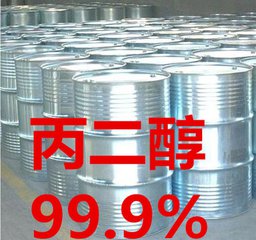PG CAS NO.57-55-6
- FOB Price: USD: 166.00-168.00 /Metric Ton Get Latest Price
- Min.Order: 5 Metric Ton
- Payment Terms: L/C,T/T
- Available Specifications:
1(20-50)Metric Ton1(50-100)Metric Ton
- Product Details
Keywords
- PPG
- P425
- electronic cigarettes
Quick Details
- ProName: PG
- CasNo: 57-55-6
- Molecular Formula: C3H8O2
- Appearance: colorless
- Application: electronic cigarettes,polyester resin,...
- DeliveryTime: 10
- PackAge: drums
- Port: Shanghai
- ProductionCapacity: 319 Metric Ton/Month
- Purity: 99.9%
- LimitNum: 5 Metric Ton
Superiority
High Purity Mono Propylene Glycol 99.95% USP Grade/ HS CODE 290532
electronic cigarettes,polyester resin, humectant, solvent, and preservative in food and for tobacco products. lower the freezing point of water.aircraft deicing fluid. veterinary medicine as an oral treatment for hyperketonaemiain ruminants.
|
Formula |
C3H8O2 |
|
Purity |
99.95% |
|
Appearance |
Colorless, Clear, Hygroscopic Liquid |
|
Class |
General Cargo |
|
CAS NO. |
57-55-6 |
|
H.S Code |
29053200 |
|
EINECS NO. |
200-338-0 |
|
UN No. |
// |
|
Moisture |
≤0.2 |
|
Free Acid ppm |
≤75 |
|
Ash ppm |
≤80 |
|
Boiling Point |
188.2℃ |
|
Molecular Weight |
76.09 |
|
BRN NO. |
1340498 |
|
Relative Density |
1.0362(20℃, 4℃) |
|
Refraction |
1.4329 |
|
Flashing Point |
98.9℃(Close)/107℃(Open) |
|
Toxicity |
Low |
|
Melting Point |
-60 |
Details
Propylene glycol is a synthetic organic compound with the chemical formula C3H2O2.
It is a viscous colorless liquid which is nearly odorless but possesses a faintly sweet taste. Chemically it is classed as a diol and is miscible with a broad range of solvents, including water, acetone,and chloroform.
It is produced on a large scale and is primarily used in the production of polymers, but also sees use in food processing, and as a process fluid in low temperature heat exchange applications. In the European Union, it has the E-number E1520 for food applications.
The compound is sometimes called α-propylene glycol to distinguish it from the isomer propane-1, 3-diol (β-propylene glycol).
Propylene glycol is often used in electronic cigarettes to improve flavour and create a better throat hit. A bottle of flavored ‘e-liquid’ for ‘vaping’ shows propylene glycol as the main ingredient. Propylene glycol is commonly used to deice aircraft.
Forty-five percent of propylene glycol produced is used as chemical feedstock for the production of unsaturated polyester resins. In this regard, propylene glycol reacts with a mixture of unsaturated maleic anhydride and isophthalic acid to give a copolymer. This partially unsaturated polymer undergoes further crosslinking to yield thermoset platics. Related to this application, propylene glycol reacts with propylene oxide to give oligomers and polymers that are used to produce polyurethanes.
Propylene glycol is used as a humectant, solvent, and preservative in food and for tobacco products. It is also one of the major ingredients, alone with glycero, of the e-liquid and cartridges used in electronic cigarettes where it is aerosolized in the atomizer.
Propylene glycol is also used in various edible items such as coffee-based drinks, liquid sweeteners, ice cream, whipped dairy products and soda.
Vaporizers used for delivery of pharmaceuticals or personal-care products often include propylene glycol among the ingredients. Propylene glycol is used as a solvent in many pharmaceuticals including oral, injectable and topical formulations, such as for diazepam and lorazepam which are insoluble in water. Certain formulations of artificial tears, such as Systane, use propylene glycol as an ingredient.
Like ethylene glycol, propylene glycol is able to lower the freezing point of water, and so it is used as aircraft deicing fluid. Water-propylene glycol mixtures dyed pink to indicate the mixture is relatively nontoxic are sold under the name of RV or marine antifreeze.
Propylene glycol is frequently used as a substitute for ethylene glycol in low toxicity, environmentally friendly automotive antifreeze. It is also used to winterize the plumbing systems in vacant structures.
Propylene glycol is used in veterinary medicine as an oral treatment for hyperketonaemiain ruminants. Glucose, which can be used in non-ruminants for this purpose, is not effective due to its consumption by the resident microbes of therumen.
Propylene glycol is partially metabolized in the rumen to propianate which can be used as an energy source. The remainder is absorbed into the bloodstream and used by the liver for gluconeogenesis.
|
Formula |
C3H8O2 |
|
Purity |
99.95% |
|
Appearance |
Colorless, Clear, Hygroscopic Liquid |
|
Class |
General Cargo |
|
CAS NO. |
57-55-6 |
|
H.S Code |
29053200 |
|
EINECS NO. |
200-338-0 |
|
UN No. |
// |
|
Moisture |
≤0.2 |
|
Free Acid ppm |
≤75 |
|
Ash ppm |
≤80 |
|
Boiling Point |
188.2℃ |
|
Molecular Weight |
76.09 |
|
BRN NO. |
1340498 |
|
Relative Density |
1.0362(20℃, 4℃) |
|
Refraction |
1.4329 |
|
Flashing Point |
98.9℃(Close)/107℃(Open) |
|
Toxicity |
Low |
|
Melting Point |
-60 |







